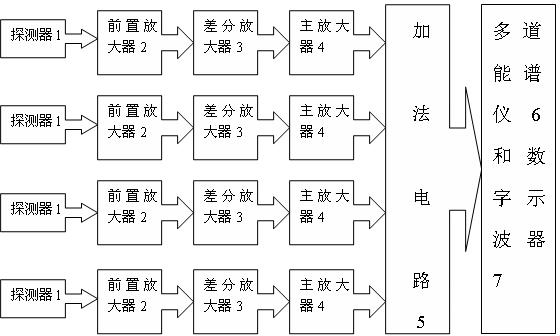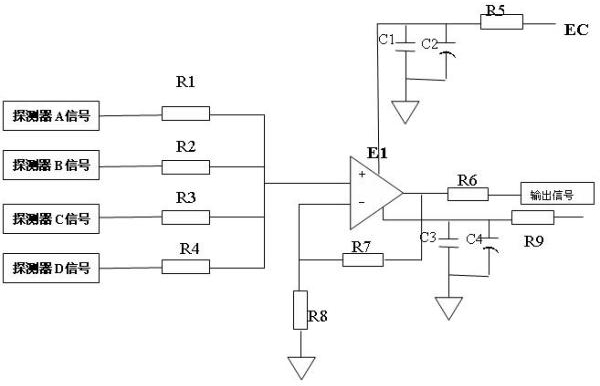Four-element parallel tellurium-zinc-cadmium nuclear radiation detector device
A nuclear radiation detector, a technology of cadmium zinc telluride, which is applied in the field of new nuclear radiation detector devices, can solve the problems of high preparation cost, high requirements for experimental equipment, low leakage current, etc., and achieves short detection time, high detection efficiency, and detection. large area effect
- Summary
- Abstract
- Description
- Claims
- Application Information
AI Technical Summary
Problems solved by technology
Method used
Image
Examples
Embodiment 1
[0020] Embodiment one: see figure 1 , the four-element parallel CdZnTe nuclear radiation device includes four CdZnTe detectors 1, each CdZnTe detector 1 respectively passes through a preamplifier 2 and then passes through a differential amplifier 3 and a main amplifier 4, and then together Connect an adding circuit 5, and finally the adding circuit 5 is connected to a multi-channel energy spectrometer 6 and a digital oscilloscope 7, and the signals measured by the four cadmium zinc telluride detectors 1 are amplified by the multi-channel energy spectrometer 6 and the digital oscilloscope. Waveformer 7 for processing.
Embodiment 2
[0021] Embodiment two: see figure 2 and image 3 , the present embodiment is basically the same as Embodiment 1, and the special feature lies in the structures of the preamplifier 2 and the differential amplifier 3:
[0022] a. In the signal input part, connect resistor R1 and capacitor C1 between the positive bias voltage and the ground terminal, load R2 on the detector D1, connect capacitor C2 between D1 and the gate of field effect transistor Q1, and the signal at D1 Terminal and C1 indirect resistor R6.
[0023] b. Take the field effect transistor Q1 as the input stage of the amplifier, the signal is input to the gate of Q1, the drain of Q1 and the DC voltage Ec are connected to the resistor R10, and R18 is connected between the source of Q1 and the ground terminal, and both ends of R18 Connect the capacitor C11 in parallel, and then input the drain signal to the positive input terminal of the differential amplifier U1A. The positive input terminal and Ec are connected...
Embodiment 3
[0024] Embodiment 3: The quaternary parallel cadmium zinc telluride nuclear radiation detector device includes a multi-channel energy spectrometer (ORTEC-PCI-8k), a digital oscilloscope (Tds3012B), a Frisch structure CZT device (10×10×5mm 3 ), radioactive source Cs 137 (16uCi), etc. Connect the preamplifier to a digital oscilloscope, and record its output waveform (as shown in the attached picture). This experiment uses the American Advanced Messurement Technology (ORTEC) company's Model 419 analog signal generator to output standard signals for debugging.
[0025] It can be seen from the figure that the output response voltage is 130mV, the rise time is 900ns, the duration is 0.2ms, the equivalent noise root mean square voltage is about 6mV, and its signal-to-noise ratio is 22:1. All performance is better than without preamplification.
[0026] Example experiment 1:
[0027] Carry out experiment with the device of embodiment three, Figure 5 is the output waveform.
[0...
PUM
 Login to View More
Login to View More Abstract
Description
Claims
Application Information
 Login to View More
Login to View More - R&D Engineer
- R&D Manager
- IP Professional
- Industry Leading Data Capabilities
- Powerful AI technology
- Patent DNA Extraction
Browse by: Latest US Patents, China's latest patents, Technical Efficacy Thesaurus, Application Domain, Technology Topic, Popular Technical Reports.
© 2024 PatSnap. All rights reserved.Legal|Privacy policy|Modern Slavery Act Transparency Statement|Sitemap|About US| Contact US: help@patsnap.com










